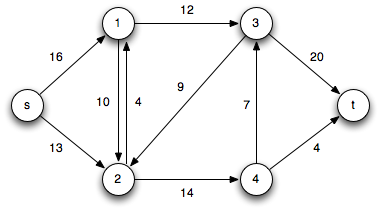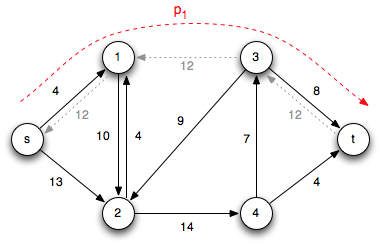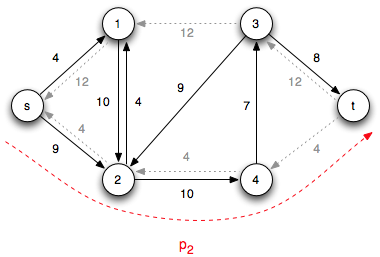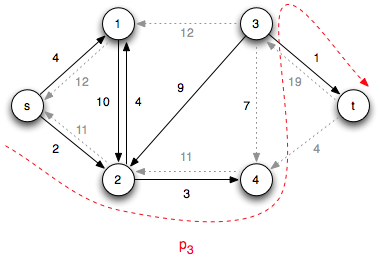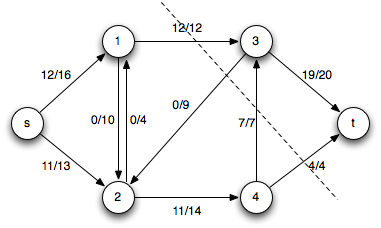Last lecture provided the framework for maximum flow problems and proved the key theorem - max-flow min-cut - that all algorithms are based on. This lecture we will investigate an algorithm for computing maximal flows known as Ford-Fulkerson.
Ford-Fulkerson Algorithm
The Ford-Fulkerson algorithm builds upon the general strategy presented last time.
1. for each edge (u,v) ∈ G.E
2. (u,v).f = 0
3. while there exists a path p from s to t in the residual network Gf
4. cf(p) = min{ cf(u,v) : (u,v) is in p}
5. for each edge (u,v) in p
6. if (u,v) ∈ E
7. (u,v).f = (u,v).f + cf(p)
8. else
9. (v,u).f = (v,u).f - cf(p)
This algorithm runs efficiently as long as the value of the maximal flow |f *| is reasonably small or if poor augmenting paths are avoided.
Edmonds-Karp Algorithm
An extension that improves upon the basic Ford-Fulkerson method is the Edmonds-Karp algorithm. This algorithm finds the augmenting path using BFS with all edges in the residual network being given a weight of 1. Thus BFS finds a shortest path (in terms of number of edges) to use as the augmenting path. With this modification, it can be shown that Edmonds-Karp runs in O(VE2).
Example
Consider the following flow network
Note that clearly |f *| ≤ 24 (the smaller of the capacities leaving the source or entering the sink).
Iteration 1: Choose the augmenting path p1 = < s, 1, 3, t > which has cf(p1) = 12 (due to c(1,3)) giving the residual network
Iteration 2: Choose the augmenting path p2 = < s, 2, 4, t > which has cf(p2) = 4 (due to c(4,t)) giving the residual network
Iteration 3: Choose the augmenting path p3 = < s, 2, 4, 3, t > which has cf(p3) = 7 (due to c(4,3)) giving the residual network
At this point there are no other augmenting paths (since vertex 3 is the only vertex with additional capacity to the sink but has no flow in from other vertices). Hence the final flow network with a min-cut shown is
with maximal flow |f *| = 19 + 4 = 23 (or 12 + 11 = 23).
